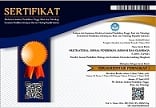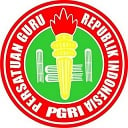Kegembiraan berolahraga, aktivitas fisik dan kebugaran fisik siswa SD di Lumajang
Abstract
Keywords
Full Text:
PDFReferences
Abadie, B. R. (1988). Construction and Validation of a Perceived Physical Fitness Scale. Perceptual and Motor Skills, 67(3), 887–892. https://doi.org/10.2466/pms.1988.67.3.887
Azevedo, M. R., Araújo, C. L. P., Reichert, F. F., Siqueira, F. V., da Silva, M. C., & Hallal, P. C. (2007). Gender Differences in Leisure-Time Physical Activity. International Journal of Public Health, 52(1), 8-15. https://doi.org/10.1007/s00038-006-5062-1
Brown, D. (2014). Negative Experiences in Physical Education Class and Avoidance of Exercise. https://scholars.fhsu.edu/theses
Cairney, J., Kwan, M. Y. W., Velduizen, S., Hay, J., Bray, S. R., & Faught, B. E. (2012). Gender, Perceived Competence and the Enjoyment of Physical Education in Children: A Longitudinal Examination. International Journal of Behavioral Nutrition and Physical Activity, 9, 1–8. https://doi.org/10.1186/1479-5868-9-26
Carson, V., Hunter, S., Kuzik, N., Gray, C. E., Poitras, V. J., Chaput, J. P., Saunders, T. J., Katzmarzyk, P. T., Okely, A. D., Connor Gorber, S., Kho, M. E., Sampson, M., Lee, H., & Tremblay, M. S. (2016). Systematic Review of Sedentary Behaviour and Health Indicators in School-Aged Children and Youth: An Update. Applied Physiology, Nutrition and Metabolism, 41(6), S240–S265. https://doi.org/10.1139/apnm-2015-0630
CSEP. (2012). Canadian Physical Activity Guidelines Canadian Sedentary Behaviour Guidelines. Canadian Society for Exercise Physiology
Dunton, G. F., Do, B., & Wang, S. D. (2020). Early Effects of the Covid-19 Pandemic on Physical Activity and Sedentary Behavior in Children Living in the U.S. BMC Public Health, 20(1), 1–13. https://doi.org/10.1186/s12889-020-09429-3
Fakhouri, T. H. I., Hughes, J. P., Brody, D. J., Kit, B. K., & Ogden, C. L. (2013). Physical Activity and Screen-Time Viewing among Elementary School-Aged Children in the United States from 2009 to 2010. JAMA Pediatrics, 167(3), 223–229. https://doi.org/10.1001/2013.jamapediatrics.122
Gill, D.L., Gross, J.B., & Huddleston, S. (1983). Participation Motivation in Youth Sports. International Journal of Sport Psychology, 14, 1–14. https://psycnet.apa.org/record/1984-09240-001
Hegde, B. M. (2018). Health Benefits of Exercise. Kuwait Medical Journal, 50(2), 143–145. https://doi.org/10.1249/01.mss.0000477455.85942.2f
Janssen, I. (2007). Physical Activity Guidelines for Children and Youth. Canadian Journal of Public Health. Revue Canadienne de Santé Publique, 98 Suppl 2(March). https://doi.org/10.2139/ssrn.2308560
Mhatre V. Ho, Ji-Ann Lee, and K. C. M., & Dien et al., 2013. (2009). Measuring Enjoyment of Physical Activity in Children: Validation of the Physical Activity Enjoyment Scale. Bone, 23(1), 1–7. https://doi.org/10.1080/10413200802593612
Motl, R. W., Dishman, R. K., Saunders, R., Dowda, M., Felton, G., & Pate, R. R. (2001). Measuring Enjoyment of Physical Activity in Adolescent Girls. American Journal of Preventive Medicine, 21(2), 110–117. https://doi.org/10.1016/S0749-3797(01)00326-9
Rovniak, L. S., Anderson, E. S., Winett, R. A., & Stephens, R. S. (2002). Social Cognitive Determinants of Physical Activity in Young Adults: A Prospective Structural Equation Analysis. Annals of Behavioral Medicine, 24(2), 149–156. https://doi.org/10.1207/S15324796ABM2402_12
Strong, W. B., Malina, R. M., Blimkie, C. J. R., Daniels, S. R., Dishman, R. K., Gutin, B., Hergenroeder, A. C., Must, A., Nixon, P. A., Pivarnik, J. M., Rowland, T., Trost, S., & Trudeau, F. (2005). Evidence Based Physical Activity for School-Age Youth. Journal of Pediatrics, 146(6), 732–737. https://doi.org/10.1016/j.jpeds.2005.01.055
Trost, S. G., Pate, R. R., Sallis, J. F., Freedson, P. S., Taylor, W. C., Dowda, M., & Sirard, J. (2002). Age and Gender Differences in Objectively Measured Physical Activity in Youth. Medicine and Science in Sports and Exercise, 34(2), 350–355. https://doi.org/10.1097/00005768-200202000-00025
U.S. Department of Health and Human Services. (2018). No TitlePhysical activity guidelines for Americans. Washington, DC: U.S. Department of Health and Human Services.
WHO. (2020). Who Guidelines in Physical Activity and Sedentary Behaviour. World Health Organization.
WHO. (2022). Ageing and Health. https://www.who.int/news-room/fact-sheets/detail/ageing-and-health
DOI: http://dx.doi.org/10.20527/multilateral.v23i4.20947
Article Metrics
Abstract view : 24 timesPDF - 1 times
Refbacks
- There are currently no refbacks.
Copyright (c) 2025 Multilateral : Jurnal Pendidikan Jasmani dan Olahraga

This work is licensed under a Creative Commons Attribution-ShareAlike 4.0 International License.
Tools:
Indexed by:

Multilateral : Jurnal Pendidikan Jasmani dan Olahraga is licensed under a Creative Commons Attribution-ShareAlike 4.0 International License.

















